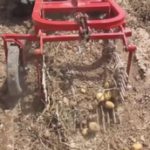Tractor Agriculture clearly discovers what is a disc harrow. Let us dig more into this secondary tillage implement. I had this topic as a question in one of my class based tests and could not answer this correctly.
Now, I am in a state to gather all of my agricultural tasks in a well synchronized manner through this web blog. Keep sharing the Love for this agriculture blog.
Harrows
A Harrow is ground leveling implement and is used to break the clod, process the soil to destroy the weeds finally. There are different types of Harrows and let us start with Disc Harrow.
Types of Disc Harrows
These types of Disc Harrows are available in different sizes, gang arrangements according to different types of tractors. These are basically of 2 types.
Trailing Type
- Mounted Type
The trailing type Harrows are pulled by Tractors and they do not have transport wheel. They sometimes have transport wheel which is worked upon mechanically or hydraulically when the Harrow needs to be transferred from the fields to the farmers place.
The Mounted Type Harrow is hitched to 3 point linkage of Tractor and is raised using hydraulic power when transportation is done.
Disc Harrows are available in many forms like:
i) Single Action
ii) Double Action
iii) Offset Type
Single Action Disc Harrow
Single Action Disc Harrows cuts the soil in only one direction. The cutting width is generally between 4’ to 20’.
Double Action Disc Harrow
Double Action Disc Harrows are also named Tandem Disc Harrows. Here, Disks are arranged in such a way that disc of front gang throws the soil in one direction and discs of rear gang throws the soil in opposite direction. This type of harrow facilitates homogeneous mixing of soil. They are best choice for such requirements.
Offset Disc Harrow
This type of harrows can be worked upon in an offset position i.e. why it is called offset harrow. A single change in hitch makes the harrow to move either to the left or right side of the tractor. This is very popular nowadays as it gives a very smooth soil.
Offset Discs are available in both mounted and trailing types. Their sizes vary according to the size and capability of a tractor.
What is a Disc Harrow (Download Pdf) Diagram
What is a Plough & Types of Plow
Components or Parts of a Disc Harrow
Disc Harrow consists of various parts listed below:
- Disc
The dished smooth disk with square holes in the center are generally used. These Discs have self sharpening features but the edges may sometimes become blunt due to rough usage on stoney field locations. The blunt edges give poor penetration and cutting. In such situation, it is necessary to ground the edges with portable electric grinder.
Most Disc Harrows have perfect round disc shape. in some cases, there is heavy residue left on the field and heavy trash cutting is required. The notched discs are an answer to such a requirement. These Disks are available in the range of 16″-24″ diameter. Most of the modern ploughs use diameter range of 1″-24″.
- Disc Gang
Disc Gang is formed with 3-13 discs assembled together on a square shaft called Gang Shaft or Gang Bolt. The spacing between the discs falls between 6″-9″ with cast iron spools.
- Frame
Each gang of discs needs a square frame
- Disc Bearing
- Disc Bumper
- Scrapers
These are placed on the harrow disks to scrap out any soil material which has hot stacked.
- Weight Boxes
In some Disc Harrows, a box is bolted in which weights are placed for the purpose of greater penetration into the soil.
There are some settings or points that should be kept in mind while using harrows.
A) Leveling: To get maximum performance from the equipments, ensure that they are in level position whether you look from top, right or left. Try these methods:
i) Leveling Left and Right: This setting is accomplished by tractor’s lower link leveling crank.
ii) Leveling Fore: You should check implement before lowering and the setting should be level fore and after. This arrangement is done by tractor top link.
To ensure uniform depth, the above stated setting should be maintained.
B) i) Side Draft: The offset disc harrow will trail nicely behind the tractor provided the side thrust of front gang is same as that of the rear part. The relative cutting angle should be carefully examined.
ii) Severe Side Draft:
In this case, the cutting depth of rear disc gang should be increased or lowered by using tractor top link. For ex: When Tractor pulls to right, rear gang should be lowered.
When tractor pulls to the left, the rear gang should be raised.
These observations will help you in troubleshooting:
- If implements choke between the discs, then you can assume these things:
i) The sped of tractor is very slow.
ii) Gangs are angled.
iii) Scrapers are not set right.
iv) Soil is too wet.
v) Gangs are not rolling nicely.




